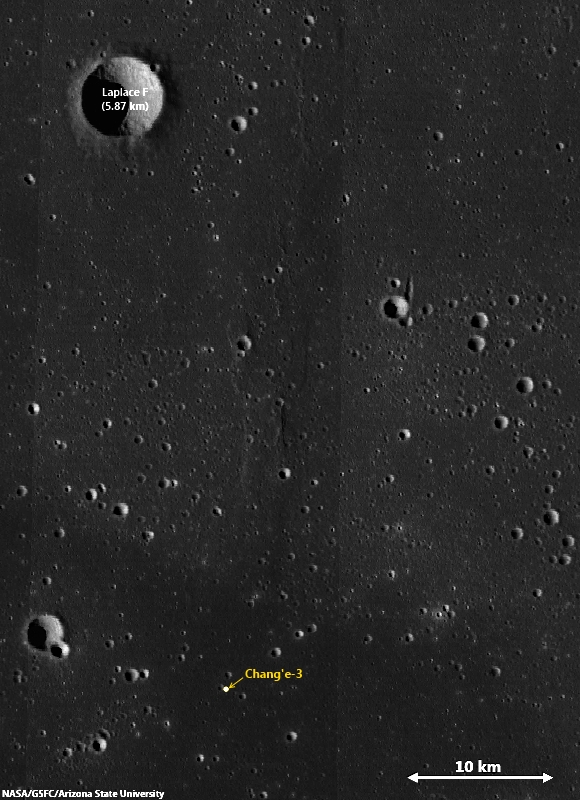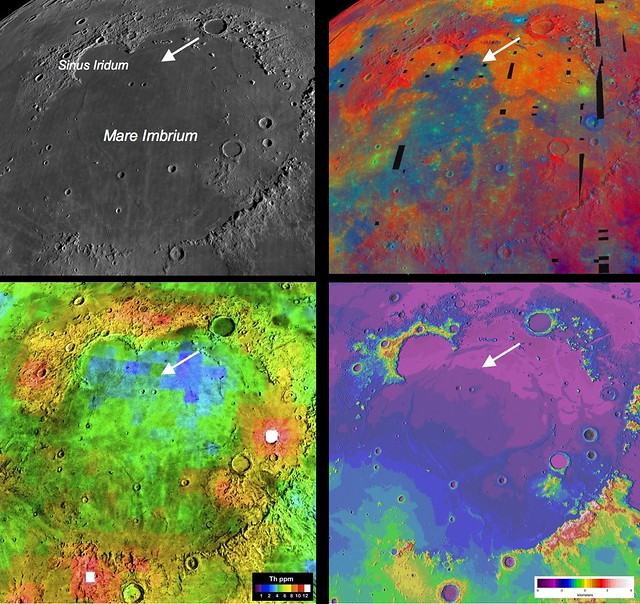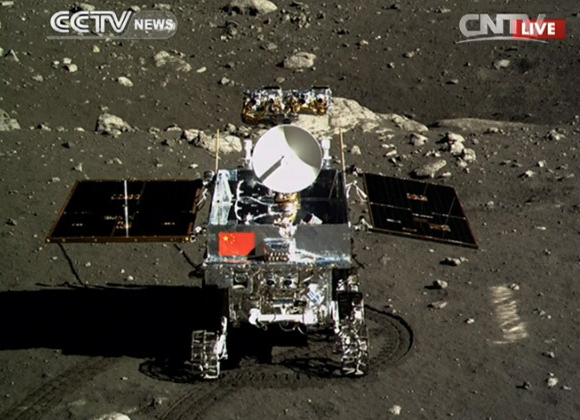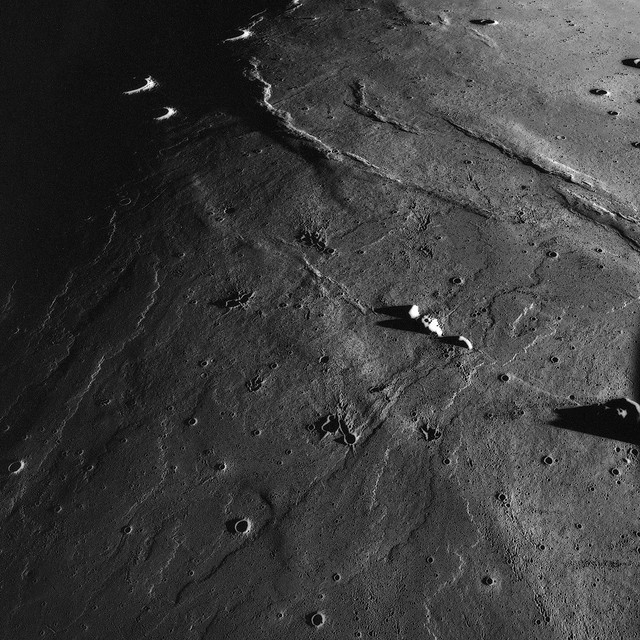Paul D. Spudis
Smithsonian Air & Space
The Chang’E 3 spacecraft, carrying the Yutu (Jade Rabbit) surface rover, successfully landed on the Moon December 14. Despite pre-mission announcements about a planned landing in the “Bay of Rainbows” (Sinus Iridum in the approved Latin nomenclature of the Moon), the spacecraft actually set down in the northern region of the “Sea of Rains” (Mare Imbrium), the far eastern edge of its designated landing box. Whether by design or fortuitous accident, this site is actually more interesting geologically than the spacecraft’s original destination.
Two major terrain types dominate the Moon’s geology. The bright, rugged highlands date from the time of crustal formation 4.5 billion years ago and were intensely cratered during the first 600 million years of lunar history. The younger areas are the dark, smooth maria, made up of iron-rich lava flows. These lavas began to erupt after the end of the heavy bombardment of the cratered highlands 3.9 billion years ago and continued sporadically for another billion years. The exact date of cessation of this volcanism is unknown and in fact, is relevant to the geology of the Chang’E 3 landing site.
 |
| The precise landing zone of China's Chang'e-3, with the Yutu rover deployed, seems to be in the middle of nowhere. From the standpoint of planetary science, however, and the cause of acquiring a better understanding of the formation of the Imbrium basin, the surface and below and very interesting. Pushed LROC WAC GLD100 mosaic (100 meter per pixel resolution) [NASA/GSFC/Arizona State University]. |
Because these lava flows are so young, the regolith (ground-up, fragmental surface layer of the lava flow – the lunar “soil”) is only a couple of meters thick. This value is relatively thin when compared with the thickness of the regolith at the Apollo sites (which ranged from 3-4 meters at the young Apollo 12 site up to over 6-8 meters at the old Apollo 11 landing site). A consequence of a thin regolith is that because the bedrock is close to the surface, small craters can excavate rocks from beneath the soil. This probably accounts for the blocky nature of the Chang’E 3 landing site; many large rocks are seen in the descent images and a blocky rim crater is evident in the first pan images retuned from the lander (image above at beginning of this post). As this crater appears to be about 10-12 m in diameter and has clearly dug through the regolith into bedrock, we can infer a regolith thickness here on the order of 2-3 meters.
 |
| Mare Imbrium basin, and the Chang’E 3 landing zone. Top left, LRO Wide Angle Camera (WAC) mosaic; top right, Clementine false-color composite; lower left, Lunar Prospector Th (thorium) elemental abundance; lower right, LRO topographic map. (Click to enlarge) [NASA/LPI]. |
In this case, the Th appears to be carried by the lava itself, a somewhat surprising result, as usually such enrichment in Th would not be expected in mafic (iron-rich) basaltic lava. This unusual chemistry is probably the result of special circumstances; the lavas here erupted through a highland crust greatly enriched in the component called KREEP, for potassium (K), the rare earth elements (REE) and phosphorus (P). On the Moon, KREEP is associated with the final phases of crustal formation and is a key substance for our understanding of the formation and evolution of the lunar crust. The KREEP component in the lavas was probably accomplished through a process called assimilation (where substances with low melting points get melted and included in hot magmas rising to the surface, which partly melt the surrounding rocks). The Chang’E 3 site appears to include lavas with that history.
One of the experiments aboard the Yutu rover is a ground-penetrating radar (GPR). This instrument beams radio waves into the surface and listens to echoes off subsurface reflectors (which can be physical or compositional boundaries). A key thing to look for at this site is evidence for the bedrock/regolith contact (depth of a couple to a few meters), possible contacts between lava flows (depths of a few to tens of meters), and contact of the mare lava fill with the basin floor (depths of hundreds of meters). In addition, this site is near one of the famous mare wrinkle ridges, those warping structures that deform the smooth mare surface inside basins. These ridges can be quite complex, involving multiple faults, tearing, scissoring and grinding as rocks fail and deform under the forces of regional compression. The GPR profiles may capture this complexity if the rover drives over a ridge during its traverse.
The Yutu rover contains both a spectral imager and an alpha-particle X-ray spectrometer. These instruments will measure the surface mineral and elemental composition for both rocks and soils. Because the rover will examine several different individual areas during its traverse, we will obtain new “ground truth” data to better understand the meaning of data obtained remotely from orbit. At a minimum, Yutu will examine the composition of the surface lava flow, which (judging from Clementine color data) appear to be very-high titanium (VHT) basalts. But because the rover has the ability to approach and examine the ejecta of large craters, we may be able to study rocks excavated from below the surface flows. Lavas to the north of the landing site are “red” in spectral images, suggesting a lower titanium content, and these lavas presumably underlie the local VHT basalts. With data from the rover, we might be able to reconstruct the volcanic stratigraphy of this region of the Moon.
Thus we are poised to investigate a new site on the Moon of considerable interest and complexity, one that displays a variety of geological units and processes. The Chang’E 3 lander and Yutu rover can provide many answers to our questions regarding the geological history of this region of the Moon and about lunar history in general. That will be a lot to learn over 3 lunar days (one lunar day equals 14 Earth days of light, sandwiched between 14 days of dark).
Originally published December 15, 2013 at his Smithsonian Air & Space blog The Once and Future Moon, Dr. Spudis is a senior staff scientist at the Lunar and Planetary Institute. The opinions expressed are those of the author but are better informed than average.



No comments:
Post a Comment